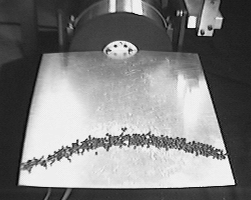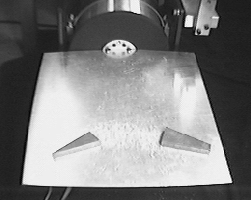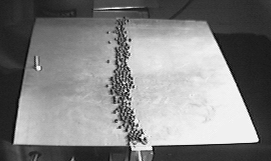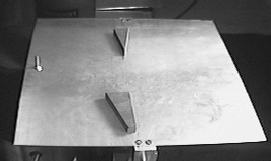Projects Archive
Vibratory Parts Feeding and Positioning - Sensorless Manipulation on a Vibratory Plate (1994-1997)
Team Members
Vivek Bhatt, Karl F. Böhringer, Bruce Donald (Cornell), Ken Goldberg (UC Berkeley)
Summary
The existing industrial parts feeders move the parts through a sequence of mechanical filters that reject parts in unwanted orientations. Here we develop a new setup that uses a different vibratory mechanism to systematically manipulate parts, by actively orienting and localizing them. The idea is to generate and change dynamic modes for a plate by varying the applied frequency of oscillation. Depending on the node shapes of the plate for these frequencies, the position and orientation of the parts can be controlled. We develop an analysis of the underlying dynamics, and show that it can be used to predict the behavior of objects placed on the vibrating plate. Using this analysis, we propose that the applied frequencies can be automatically sequenced to obtain a "sensorless" strategy for manipulating a given object.
The existing industrial parts feeders move the parts through a sequence of mechanical filters that reject parts in unwanted orientations. In this paper we develop a new setup that uses a different vibratory mechanism to systematically manipulate parts, by actively orienting and localizing them. The idea is to generate and change dynamic modes for a plate by varying the applied frequency of oscillation. Depending on the node shapes of the plate for these frequencies, the position and orientation of the parts can be controlled. We develop an analysis of the underlying dynamics, and show that it can be used to predict the behavior of objects placed on the vibrating plate. Using this analysis, we propose that the applied frequencies can be automatically sequenced to obtain a "sensorless" strategy for manipulating a given object.
Selected Publications
-
K. F. Böhringer, V. Bhatt, B. R. Donald, K. Y. Goldberg, "Algorithms for Sensorless Manipulation Using a Vibrating Surface." Algorithmica 26(3/4):389-429, R. P. Motwani and P. Raghavan, eds., March/April 2000. Paper.
-
K. F. Böhringer, V. Bhatt, and K. Goldberg, "Sensorless Manipulation Using Transverse Vibrations of a Plate." IEEE International Conference on Robotics and Automation (ICRA), vol. 2, pp. 1989-1986, Nagoya, Japan, May 21-27, 1995. Nominated for Best Conference Paper Award. Paper.
A complete list of our publications (many of them available online) can be found here.
Acknowledgements
-
NSF Postdoctoral Associateship CDA-9726389, CAREER award ECS-9875367
-
NSF IRI-8802390, IRI-9000532, IRI-9201699, NSF/DARPA IRI-9403903, IRI-9530785,CDA-9726389, 9802068, CISE/CDA-9805548, EIA-9818299, IRI-9896020, EIA- 9901407, IIS-9906790
-
AFOSR, the Mathematical Sciences Institute, Intel Corporation, AT&T Bell laboratories, and an equipment grant from Microsoft Research.




